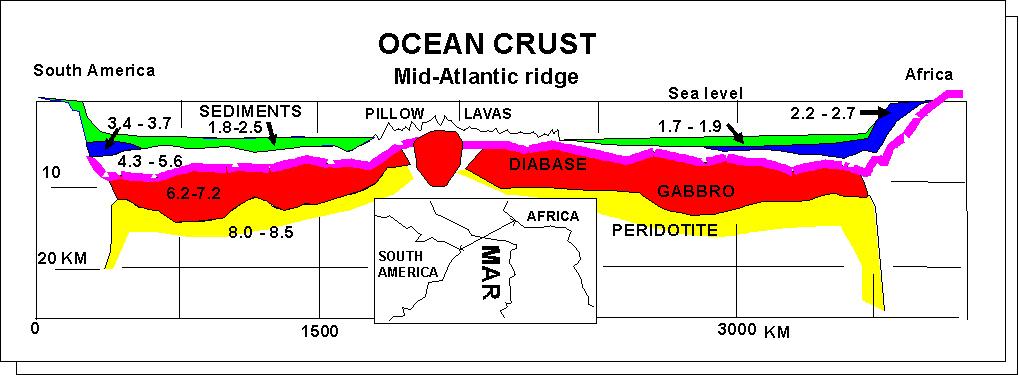Click here to return to course outline.
Go to 'figures/overhead' section.
ORIGIN OF OCEANIC CRUST
Because pillow lava is the rock type that invariably appears from beneath the abyssal sediments that flank the exposed parts of Mid-Ocean ridges, it is generally considered that ocean crust beneath the uppermost veneer of relatively unconsolidated sediment of oceanic abyssal plains is formed of pillow
lava.

The deeper parts of oceanic crust cannot however be so directly examined, and ideas concerning its nature were originally based on a simple comparison of
the P-wave velocity structure of oceanic crust with the measured P-wave characteristics of a range of ultramafic, mafic and felsic rock types. One possible example of an up-faulted but otherwise in-situ section of oceanic crust however does occur on Macquarrie Island, located on the Alpine fault between New Zealand and Antarctica. The section here is formed of pillow basalt, diabase, gabbro, troctolite, and ultramafic rocks. Overhead sequence:
Crustal section of the ocean floor off the east coast of Argentina
The seismic structure of the Atlantic (09ocesct.gif)
Compressional wave velocities for granite and gabbro
Distribution of Ophiolites: location of MacQuarrie Island; (09ophloc.gif)
Geology Map of the north part of Macquarrie Island
Layered cumulates and sheeted diabase, Macquarrie Island
Global distribution of ultramafic-gabbro-diabase-pillow lava complexes (ophiolites)
Ophiolites in geosynclinal theory
The 1959 Alpine "laccolith" model of ophiolite
Location of Oman (09ophloc.gif)
Reinhardt - the Oman ophiolite and the discovery of sheeted_diabase. (09ophiol.gif)
The Bay of Islands complex - mantle peridotite; lherzolite; harzburgite; cumulate peridotite cumulate gabbro; roof gabbro; sheeted diabase. (09wnewf.gif)
Magma chamber model of ocean crust formation. (09ocform.gif)
FIGURES
The P-wave velocity structure of oceanic crust.07ocesct.gif
Measured P-wave of granite and gabbro.
Global distribution of ophiolite complexes and the location of MacQuarrie Island.09ophloc.gif
Macquarrie Island diabase.09macdiab.jpg
Macquarrie Island troctolite.09mactroct.jpg
Geological map of Newfoundland - the Bay of Islands ophiolite of western Newfoundland.09nfdlnd.gif
Location of ophiolite in the Alpine orogenic system according to the eugeosyncline model.09ophiol.gif
The giant basaltic effusion model for ophiolites.09ophiol.gif
The Bay of Islands ophiolite complex of Western Newfoundland.
Formation of oceanic crust at an oceanic spreading centre.
Click here to return to course outline.
http://www.uwo.ca/earth/ugrad/courses.html